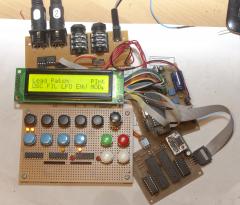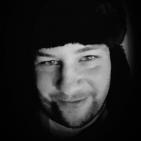-
Posts
15,247 -
Joined
Content Type
Profiles
Forums
Blogs
Gallery
Everything posted by TK.
-

Control Surface Problems (led's 1/2 lit, buttons control wrong thing)
TK. replied to wicked1's topic in MIDIbox SID
LEDs are time multiplexed on the MB6582 HW variant, it's normal that the brightness isn't 100% Best Regards, Thorsten. -
Die Kondensatoren sind zwingend notwendig, damit der Schwingkreis anlaeuft. Sie koennen weder weggelassen werden, noch durch etwas anderes ersetzt werden. Auch der Wert (22..33 pF) ist wichtig, ansonsten bleibt der PIC einfach stehen. Vielleicht hast Du noch irgendwo ein altes Geraet zum Ausschlachten? Gruss, Thorsten.
-
CS1 = J28:SDA CS2 = J28:SC CS3 = J28:WS CS4 = J28:MCLK Best Regards, Thorsten.
-
Of course, with SNAPSHOT_AT_POWERON it is intended to send the current pot and button positions, otherwise this function wouldn't really make sense (like you are saying). If only 0x00 values are sent, it seems to be a bug! I will fix this soon. Btw.: the MIDIbox64 firmware is assembly based, coding in assembly is difficult and error prone. Thats one of the reason why this function doesn't work - I have to try and fix it by myself. Btw2.: MIOS32 based projects are programmed in C and C++, so that such bugs are less likely ;-) Best Regards, Thorsten.
-
Tja, dann sollte ich mir wohl mal einen STEC12E bei Reichelt bestellen, um es selbst auszuprobieren und das Pinning vielleicht auch mal mit einem Foto zu dokumentieren. DETENTED3 ist eigentlich ein Workaround, bei dem der Schaltpunkt fuer den Increment verschoben wird. Spaeter hat sich herausgestellt, dass der Anwender lediglich den "Common" Pin (geht nach Masse) falsch angeschlossen hatte - leider finde ich das Posting nicht mehr. Gruss, Thorsten.
-
Oh my god! Thanks for the eye opener! :-/ Of course, instead of "220 Ohm resistors can be removed" actually I meant "220 Ohm resistors can be replaced by cables" - I corrected this in the schematic. I'm sorry for the trouble! Best Regards, Thorsten.
-
Ich werde die CC Belegung nicht aendern, da die Bank-CCs bei den meisten DAWs voll konfigurierbar sind (CC0/CC32 getrennt einstellbar - falls nicht: darauf verzichten!). Ausserdem sind viele Sourcen - auch ausserhalb der Firmware, wie bspw. der JSynthLib und Ctrlr basierte Editor - auf die vorhandene CC Struktur abgestimmt. Die moechte nun niemand mehr anpassen. Persoenlich finde ich die vorhandene CC Struktur besser als eine verstueckelte oder unvollstaendige Sammlung die sich in die Luecken der Standard-CC Belegung einordnet. Die restlichen CCs liesen sich dann naemlich nur noch via SysEx oder NRPN ansteuern, fast alle DAWs haben damit nach wie vor Probleme, und somit koennte man nicht mehr saemtliche Parameter automatisieren. Ich bezweifle, dass Dein Encoder fuer DETENTED3 ausgelegt ist, hast Du meinen Vorschlag ausprobiert? Wie verhaelt sich der Encoder bei vertauschtem Pinning? Oder soll ich nochmal genauer erklaeren, was ich meine? Gruss, Thorsten.
-
-
The MIOS32_BOARD_* functions for LPC17xx are located here: http://svnmios.midibox.org/filedetails.php?repname=svn.mios32&path=%2Ftrunk%2Fmios32%2FLPC17xx%2Fmios32_board.c By searching for MIOS32_BOARD_J28 you will also find the exact pinning. Note: this file shouldn't be changed, if you need something similar, copy&paste&rename the functions in your application. Best Regards, Thorsten.
-
Hi, the pins are directly programmed into the universal driver: http://svnmios.midibox.org/filedetails.php?repname=svn.mios32&path=%2Ftrunk%2Fmodules%2Fapp_lcd%2Funiversal%2Fapp_lcd.c Search for MIOS32_BOARD_J28 Currently they can't be changed from external, the source code has to be modified directly. There will be a "weak" function reference in future which will allow to overload the CS pin initialisation and control from external. Best Regards, Thorsten.
-
The SysEx command is correct, see also the documentation: http://svnmios.midibox.org/filedetails.php?repname=svn.mios&path=%2Ftrunk%2Fapps%2Fsynthesizers%2Fmidibox_fm_v1%2Fdoc%2Fmidibox_fm_sysex_implementation.txt Type definitions ~~~~~~~~~~~~~~~~ 00: Voice #1, EEPROM access (exception: command #06 always accesses RAM) 01: Voice #2, EEPROM access (exception: command #06 always accesses RAM) 02: Voice #3, EEPROM access (exception: command #06 always accesses RAM) 03: Voice #4, EEPROM access (exception: command #06 always accesses RAM) 08: Voice #1, direct RAM access 09: Voice #2, direct RAM access 0A: Voice #3, direct RAM access 0B: Voice #4, direct RAM access 10: Drums, EEPROM access 18: Drums, direct RAM access 70: Ensemble, EEPROM access 78: Ensemble, direct RAM access [/code] This is the actual issue - please use r946, you will find the link in the first posting! Best Regards, Thorsten.
-
There is no problem - you can safely ignore these warnings. The script has generated a .syx file (not a .hex file). E.g. if you named your .ini file 'dinama.ini', you should now have a 'dinama.syx' Just upload this new .syx file with the SysEx tool which is part of MIOS Studio -> done! You already enabled the "SNAPSHOT_AT_POWERON" option in your .ini file. You don't need to compile a .hex file You've generated a .syx file with the "mk_syx.pl" script, it contains the configuration (and no program code). Now you have to upload the .syx file with the SysEx tool. Best Regards, Thorsten.
-
Hi, the modules are using different interfaces, therefore we can't say that each firmware would support N modules of any kind... The maximum amount of connectable modules mainly depends on the interface type, hardware resources and firmware capabilities. Therefore you've to ask more concretely which setup you are planning to use (if the user manual of the appr. application doesn't already help) MBHP_CORE_LPC17 cores are working independent from each other; especially if they are connected via USB to a PC/Mac there is direct access to each core (each one has an own MIDI interface) Very difficult to calculate if we don't know the details of your setup - but the most simple way is to measure the power consumption of each module separately and to accumulate it - or if you don't need such detailed informations, just measure the complete current of your setup to decide if your PSU is strong enough (or too strong) The MBHP_CORE_LPC17 powers the connected modules via Vs/Vd lines of the interface. Almost everywhere... ;-) Where are you living? Maybe somebody can give you a special tip for your country. Best Regards, Thorsten.
-

[solved] How to send initial AIN state to MIDI OUT at startup?
TK. replied to nsunier's topic in MIOS programming (C)
Duplicate: -
If you are using the MIDIbox64 firmware, you only need to enable the SNAPSHOT_AT_POWERON option. No programming required! Best Regards, Thorsten.
-

SwinSID - a pin compatible alternative to the SID chip
TK. replied to TheFumigator's topic in MIDIbox SID
No, this is definitely not possible. ;-) MBSID doesn't only stupidly forward MIDI events to the SIDs, it has a sound engine running in background which modulates SID parameters at high resolution and update rate for best results. This sound engine consumes CPU time and RAM, it's tailored around the resources of a single PIC to get the max out of it. Scalability is given by using a dedicated PIC for each pair of SIDs, and by connecting them via a CAN network (e.g. so that only a single control surface is required). Best Regards, Thorsten. -
Yes, it seems that J27 jumper is connected, so that the bootloader is running instead of the application. Just remove it, the application should start thereafter. Best Regards, Thorsten.
-

SwinSID - a pin compatible alternative to the SID chip
TK. replied to TheFumigator's topic in MIDIbox SID
Nice layout work - only 7 bridges and a very pragmatic oscillator! :-) Easy: you can connect the address, data and control lines (provided by the outputs of the 74HC595 shift registers) 1:1 with the SwinSID and SID inputs. Also the two chip select lines (coming from PIC) can be shared - one CS for the left, the other CS for the right channel. Best Regards, Thorsten. -
Ja, hier koennte der Fehler liegen. Die MBFM haelt sich nicht an die Vorgaben der Standard-CC Belegung, da der Zugriff auf saemtliche Parameter via CC (statt dem komplizierteren NRPN Protokoll, das von Ableton uebrigens nicht sauber unterstuetzt wird) bevorzugt wurde. Ist Dir der automatisierte Bank Change so wichtig? Dann koenntest Du den CC#32 fuer OP1 Attack Rate im File src/mbfm_par_table.inc deaktivieren, oder auf einen anderen CC legen. Zum Encoder-Problem: ich vermute, dass Du die Pins falsch verloetet hast. Es gibt drei moegliche Pin-Kombinationen, probiere mal die beiden anderen Varianten aus. Gruss, Thorsten.
-

Midibox and 9090 Drum Individual Accent... is there a Way to realise this
TK. replied to jamie's topic in MIDIbox SEQ
Hi, yes, there is some progress! I got the prototype PCB, it's almost completely stuffed. I need another day to solder the LEDs + resistors for velocity control, and some time to enhance the firmware. Best Regards, Thorsten. -
Change to the ensemble page and move the rotary encoder - what happens? Best Regards, Thorsten.
-
You need a rotary encoder in order to scroll the ensemble page to the SAV item. You need it anyhow to change the bank and patch number - there is no other way. For more details, see "First Steps": http://www.ucapps.de/midibox_sid_manual_fs.html And "Ensembles": http://www.ucapps.de/midibox_sid_manual_e.html Best Regards, Thorsten.
-
Exploring Bangalore :)
-
My feedback once I'm back from business travel. Best Regards, Thorsten.




